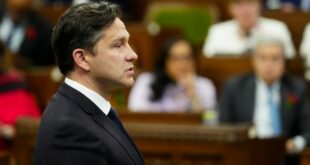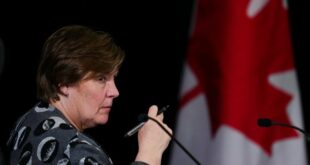Alberta may ask Ottawa to help manage provincial pension plan. Ontario tried that once. Didn’t go well.

It may seem like a pile-on by now to Premier Danielle Smith and the United Conservatives.
The Tory-run Ontario government came out Wednesday sounding the same alarm about Alberta’s pension-plan flirtation as have (deep breath) Prime Minister Justin Trudeau, Conservative Leader Pierre Poilievre, the Alberta NDP, British Columbia’s premier, Newfoundland and Labrador’s premier, the Calgary Chamber of Commerce, seniors’ groups, organized labour, the Canadian Federation of Independent Businesses, and various economists and pensionexperts.
But that isn’t to say one should dismiss the remarks of Ontario Finance Minister Peter Bethlenfalvy about a fractured Canada Pension Plan as just another voice in a growing chorus. His intention is to get all his provincial and territorial finance ministers together, plus federal Finance Minister Chrystia Freeland, for an “urgent meeting” to discuss Alberta’s idea as a pan-Canadian crisis in the making — a meeting she’s agreed to.
“As co-stewards of the CPP, it is our shared responsibility to safeguard the financial sustainability of the plan on behalf of workers and retirees across Canada,” Bethlenfalvy wrote Freeland in an open letter (that’s how one communicates on pension policy these days, I suppose).
He also became the latest person to question Alberta’s assertion they’re entitled to more than half of CPP’s asset fund, worth one-third of a trillion dollars — a pie grab that would force other Canadians to pay more in contributions or receive smaller benefits to restore the fund’s long-term health.
Given that Québec isn’t part of CPP, the two largest partners in the pension plan (B.C. and Ontario) are now opposed, and they constitute 65 per cent of the population of that nine-province coalition. (Alberta represents 17 per cent of it.)
When Alberta fought Ottawa on carbon tax and the Impact Assessment Act, it had fellow provinces joining the court fight. When it tried axing equalization in a referendum, others looked the other way. But this is an anti-federal Alberta initiative that its neighbours and Confederation confreres see as a hostile, nation-damaging act.
Rather than further escalating the hostility, Alberta Finance Minister Nate Horner agreed to host his counterparts in Calgary to talk pensions, along with some issues that get his province’s nose out of joint (see: carbon tax and equalization, above).
Ontario’s pension pratfall
But the depiction of this as a federal-provincial problem isn’t the only reason Albertans may want to listen to some pension warnings from Ontario. Canada’s largest province has some experience pursuing a standalone provincial pension plan of sorts, and has scars to show for it.
A little less than a decade ago, Kathleen Wynne was premier, and she worried publicly that Ontarians weren’t saving enough for retirement. So her Liberal government proposed a supplementary contribution and benefits program, the Ontario Retirement Pension Plan (ORPP) — to serve in addition to CPP.
As the province began developing this program, it pursued a notion that has also occurred to both the Smith government and the authors of its Lifeworks report: that federal departments and the investment board that already manage the CPP could also run this provincial pension program.
Lifeworks set a huge range for setup costs for an Alberta Pension Plan, between $175 million and $2.2 billion, and the low end assumes Alberta could piggyback on what CPP and Ottawa already did in collecting contributions, dispersing benefits and managing the gargantuan fund.
Ontario had the same thought for its ORPP. But when it went pleading to the Canada Revenue Agency and other federal bodies, the answer every time came back: No. Do it yourself.
“They had absolutely no time whatsoever for Ontario to create a new thing for them to do,” recalled Mahmood Nanji, who was the associate deputy minister for Ontario’s Finance ministry and in charge of setting up ORPP. “We told them we would pay every cent of additional talent that they were going to use on this, and they refused.”
Instead, Ontario had to establish its own pension administration corporation.
Part of the refusal may have been partisan; the Ontario Liberals were asking the Stephen Harper Conservatives in Ottawa, who had little interest in supporting an initiative that added to anybody’s payroll taxes, and campaigned in 2015 against it.
After the Trudeau Liberals won that year, Ontario’s problems were solved in a different way: the new federal government created an expanded, supplementary CPP along the lines of what Wynne was trying to do on her own.
There could be further motivation for any stripe of government in Ottawa to decline helping manage an Alberta pension program. Ontario’s ambitions then weren’t going to materially harm other provinces’ ability to provide retirement savings.
On the other hand, as Horner has noted, the Canada Pension Plan Investment Board may prefer to take on management of Alberta’s fund, to keep its assets all together rather than liquidate.
But Ontario’s example shows that much will depend on the good graces and co-operative spirit of the national entities to take on administration of Alberta’s program, after that province would have just ditched one of co-operative Canadian federalism’s most revered institutions.
“They are hopelessly naive in believing in that, and it’s rubbish in thinking that’s an automatic thing,” Nanji says.

Currently, Nanji is a retired provincial civil servant and a fellow at the Ivey Business School at Western University in London, Ont.
He recalls warning the Ontario cabinet of the myriad risks and headaches of creating its own pension program, and worries that Smith isn’t being realistic about the murkiness of both the upsides and downsides of an Alberta pension fund.
“To assume that somebody is just going to take $350 billion of assets, build a system in three years, invest it just as well [as CPP]?” Nanji asks. “It’s not an ideological point, not even a policy point. It’s just impractical and nonsensical in many ways.”
While Alberta’s premier is touting a wide array of perceived benefits of a Canada Pension Plexit, the critics keep lining up in the rest of Canada, seeing nothing but peril for their own residents, and acting accordingly.
ABOUT THE AUTHOR
Jason Markusoff analyzes what’s happening — and what isn’t happening, but probably should be — in Calgary, Alberta and sometimes farther afield. He’s written in Alberta for more than two decades, previously reporting for Maclean’s magazine, Calgary Herald and Edmonton Journal. He appears regularly on Power and Politics’ Power Panel and various other CBC current affairs shows. Reach him at jason.markusoff@cbc.ca
*****
Credit belongs to : www.cbc.ca
 Atin Ito First Filipino Community Newspaper in Ontario
Atin Ito First Filipino Community Newspaper in Ontario






